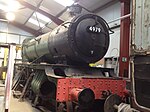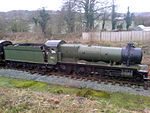GWR class 4900
| GWR class 4900 | |
|---|---|
|
5976 Ashwicke Hall in Exeter St David's MPD 1953
|
|
| Numbering: | 4900 (prototype), 4901 - 4999, 5900 - 5999, 6900 - 6958 |
| Number: | 258 + 1 prototype |
| Manufacturer: | Swindon Railway Works |
| Year of construction (s): | 1924 (prototype), 1928–1943 |
| Retirement: | 1959-1965 |
| Axis formula : | 2'C |
| Type : | 2'Ch2 |
| Gauge : | 1435 mm ( standard gauge ) |
| Length over buffers: | 19.21 m |
| Height: | 4.045 m |
| Width: | 2,724 m |
| Smallest bef. Radius: | 141 m (when driving slowly), 161 m (general) |
| Service mass: | 76.2 t |
| Wheel set mass : | 19.3 t |
| Starting tractive effort: | 121 kN |
| Coupling wheel diameter: | 1829 mm |
| Driving wheel diameter: | 1829 mm |
| Impeller diameter front: | 914 mm |
| Number of cylinders: | 2 |
| Cylinder diameter: | 470 mm |
| Piston stroke: | 724 mm |
| Boiler overpressure: | 1.55 kPa |
| Radiant heating surface: | 14.4 m² |
| Tubular heating surface: | 156.7 m² |
| Superheater area : | 24.4 m² |
| Water supply: | 16 m³ - 18 m³ |
| Fuel supply: | Hard coal |
| Train heating: | steam |
| Coupling type: | Screw coupling |
The Class 4900 or Hall class of the Great Western Railway was a series of tender locomotives with a 2'C wheel arrangement with a two-cylinder superheated steam engine based on a design by Charles Collett . 259 locomotives with the road numbers 4900-4999, 5900-5999 and 6900-6958 were built. They were suitable for both passenger and freight train service and formed the model for class 5 of the LMS and class B1 of the LNER .
history
In 1923 the GWR was well equipped with locomotives for fast passenger train service like the Saints and the Stars , and the Castles began their service. The 1'C locomotives of the GWR class 4300 built for passenger and freight train services , however, were no longer able to cope with the increasing train loads. George Jackson Churchward had therefore designed the 1'D-coupled GWR Class 4700 with drive wheels of 5 feet 3 inches (1727 mm) in diameter for fast freight trains and reinforcement passenger trains. Although a successful construction, they were only suitable for a few routes because of their size. Churchward's successor, Collett, therefore found a Saints- derived locomotive with smaller wheels and a leading bogie to be more suitable and therefore had track number 2925 Saint Martin converted to a 6ft 3 inch (1829 mm) drive wheel diameter in 1924 . The cylinder position was adapted to the new chassis and a driver's cab of the castles was installed. During the trials, which lasted until 1927, further changes were made to the boiler and steam lines.
After the successful attempts, a series of 80 locomotives were ordered in Swindon in 1928 , which were delivered by 1930 with the numbers 4901 to 4980. The prototype was given the new number 4900. The first 14 locomotives were tested on the demanding Cornish Main Line and proved themselves so well that 20 more copies were ordered when the first series was completed (track numbers 4981-99 and 5900). Further orders followed in the 1930s and early 1940s, until 1943, when the 259th Oxburgh Hall locomotive with track number 6958 was delivered. Except for the prototype, all were named after English and Welsh mansions ( Halls ). 71 more locomotives were delivered under Collett's successor Frederick Hawksworth as Modified Halls with numerous improvements adapted to technical progress.
technical features
The series machines differed little from the prototype. The impeller diameter has been reduced from 3 feet 2 inches (965 mm) to 3 feet (914 mm) and the valve stroke increased to 7.5 in (191 mm) compared to the Saints . The mass of the locomotive increased by 2 long tons 10 cwt (2.5 t) to 75 long tons 0 cwt (76.2 t), and the pulling force of 27.275 lbf (121.33 kN) exceeded the Saints' 24.935 lbf (110.92 kN) . Originally the locomotives were equipped with Churchward tenders with a water capacity of 3,500 imp gal (16,000 l), from track number 4958 they received Collett's larger tenders with 4,000 imp gal (18,000 l) water capacity. Some locomotives delivered later also received smaller tenders, if they were available when they were put into service.
The high axle load of the locomotives prevented them from being used on branch lines. Nevertheless - as the high number of units showed - they were operationally successful and are occasionally regarded as the first true multi-purpose locomotives and thus the forerunners of the LMS class 5, the LNER class B1 and the BR Standard Class 5. However, successful multi-purpose locomotives with the 1'C and 2'C axles had already been built for the GWR and other British railways, including the GWR class 4300, which was to be replaced by the class 4900.
Retirement and conservation
Except for track number 4911 Bowden Hall , which was scrapped in 1941 after a bomb damage, all Halls were taken over by British Railways in 1948. Official retirement began in 1959 when the prototype Saint Martin was withdrawn from circulation. By then it had covered a total of 2,092,500 miles (before and after the conversion). By 1965 the entire class had been retired. Eleven locomotives have survived, all of which had been parked at Woodham Brothers' metal recycling plant in Barry . Seven of them were in the museum. Track number 4942 Maindy Hall was converted into a Saint locomotive and put into service in April 2019 as Lady of Legend with the number 2999. Track number 4965 Rood Ashton Hall is approved for route service and can therefore carry special trains. Lane number 5972 Olton Hall was used in the Harry Potter films . Other locomotives are currently being refurbished.
Preserved machines
| number | Surname | image | Built | Retired | Owner | Location | status | Approval for route service | Remarks |
|---|---|---|---|---|---|---|---|---|---|
| 4920 | Dumbleton Hall |

|
March 1929 | December 1965 | South Devon Railway | Switched off | No | ||
| 4930 | Hagley Hall |

|
May 1929 | December 1963 | Severn Valley Railway | Severn Valley Railway | Is being overtaken | No | |
| 4936 | Kinlet Hall |

|
June 1929 | January 1964 | Kinlet Hall Loco. Co. | Tyseley Locomotive Works | Is being overtaken | No, provided | |
| 4942 | Maindy Hall |

|
July 1929 | December 1963 | Didcot Railway Center | Didcot Railway Center | Conversion to GWR class 2900 Lady of Legend | No, provided | Conversion to Saint class |
| 4953 | Pitchford Hall |

|
August 1929 | May 1963 | Epping Ongar Railway | Epping Ongar Railway | Is being overtaken | No | |
| 4965 | Rood Ashton Hall |

|
November 1930 | March 1962 | Tyseley Locomotive Works | Tyseley Locomotive Works | Operational | Yes (2009-2019) | |
| 4979 | Wootton Hall |

|
February 1930 | December 1963 | Furness Railway Trust | Ribble Steam Railway | Is being restored | No | |
| 5900 | Hinderton Hall |

|
March 1931 | December 1963 | Didcot Railway Center | Didcot Railway Center | Fixed museum locomotive | No | Pulled nine former GWR passenger cars on a route from Didcot in the 1970s. |
| 5952 | Cogan Hall |

|
December 1935 | June 1964 | Betton Grange Society | Llangollen Railway | Switched off | No | Tender and some parts used for GWR class 6800 Betton Grange . Should be restored after completion of No. 6880. |
| 5967 | Bickmarsh Hall |

|
March 1937 | June 1964 | Northampton & Lamport Railway | Will be worked up | No | ||
| 5972 | Olton Hall |

|
April 1937 | December 1963 | David Smith | Warner Brothers Studio Tours | Fixed museum locomotive | No, provided | Was used under the name Hogwarts Castle with red paint in the Harry Potter films. |
Individual evidence
- ^ Le Fleming, HM (November 1960) [1953]. White, DE, ed. The Locomotives of the Great Western Railway, part eight: Modern Passenger Classes (2nd ed.). Kenilworth: RCTS. S. H29.
- ^ Le Fleming & White 1960, p. H29
- ^ Le Fleming & White 1960, p. H30
- ^ Herring, Peter (2004). Classic British Steam Locomotives. Wigston: Abbeydale Press. P. 118. ISBN 1-86147-138-6
- ^ Casserley, HC (1960). The Historic Locomotive Pocket Book. London: Batsford. Pp. 217, 222.
- ^ Casserley, HC (1961). Locomotives of British Railways. London: Spring Books. P. 28.
- ^ Riley, RC (1966). Great Western Album. Shepperton: Ian Allan. P. 90. ISBN 0-7110-0073-5
- ↑ a b The Saint Project . Retrieved April 10, 2019.
- ^ Nigel Devereux: April launch date for Didcot's Saint No. 2999 . In: Railway Magazine . February 18, 2019.
- ↑ https://www.flickr.com/photos/13296226@N02/4541734360
- ↑ The name of the locomotive in the film is considered a joke in museum railroad circles, since the locomotives of the much larger GWR class 4073 are referred to as castles .
